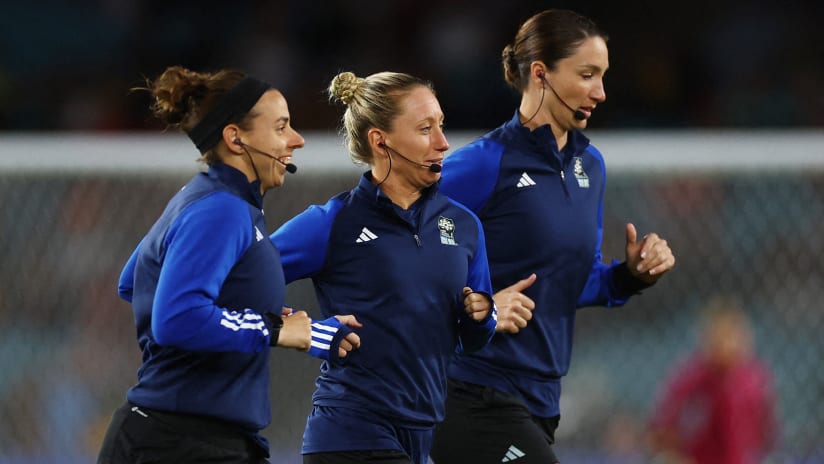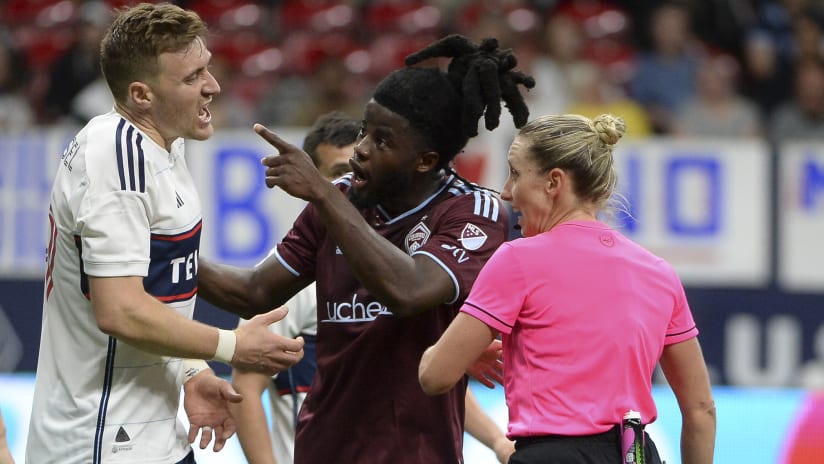NEW YORK – The most radical technological advancement in modern soccer is already one year old … in MLS, at least.
The two people responsible for Video Review's implementation in the U.S. and Canada in August 2017 – Howard Webb and Jeff Agoos – have overseen its use in over 400 official league matches. There’s plenty for them to reflect on.
“It’s probably better than I expected it to be, if I’m honest,” Webb, the General Manager of the Professional Referee Organization (PRO), told MLSsoccer.com last week.
“Looking back at it from implementation weekend in August 2017 when we were first starting this, I think we really thought it could be something special,” added Agoos, MLS’s Senior Vice President of Competition. “I think it’s lived up to that. I think it’s been an incredibly positive test for our league and a really positive initiative for our sport, and it’s shown that if done well, you can correct clear errors on game-changing decisions without impacting the flow of the game.”
Agoos said that overall, the four categories of plays eligible for Video Review – goals, red cards, penalty kicks and cases of mistaken identity – have been called correctly 98.6 percent of the time either during the run of play or after Video Review in 2018, up from 95% in 2017.
A league spokesperson added that out of the 95 times that Video Review was used through Week 27 of the 2018 season, PRO has determined 84 uses have resulted in the correct call being made. Of the remaining 11, two were determined to inconclusive and nine were determined to be incorrect.
VAR learning lessons
MLS was one of the first three leagues to introduce Video Review and as with any new project of this magnitude, there still is room for growth. Both Webb and Agoos admit that there have been errors, and both pointed out concrete measures PRO and MLS are taking as they try to eliminate their root causes.
Teams have been on both ends of calls this year. PRO highlighted incidents in two separate New York Red Bulls games, one which went for the Red Bulls – when an Ignacio Piatti goal for Montreal was ruled out for offside after initially being given – and one that went against them – in which Daniel Royer was sent off against FC Dallas after review – as two of the best examples of the use of Video Review this year to overturn calls that otherwise would have been incorrect.
Among the highest-profile decisions that haven't gone a team's way: 1) A penalty kick that was incorrectly given to Crew SC’s Patrick Mullins and not identified as a clear and obvious error by the VAR late in Columbus’ 3-2 win against Orlando on July 21. Webb said that call was a case of the VAR's threshold for “clear and obvious” being too high. PRO later issued a statement clarifying the Mullins call was incorrect; 2) A straight red card that was shown to Houston’s Tomas Martinez in the Dynamo’s home loss to Philadelphia on July 25. The Martinez red card was rescinded after an appeal.
Webb said both calls exhibited some of the specific difficulties that have come with Video Review, and both highlight areas in which MLS and PRO are working to improve the system.
According to Webb, the error on the Martinez play was caused by the VAR focusing too much on one detail and losing the broader context of the play.
As Webb noted, the image of the moment Martinez contacted Trusty looked ugly. But the context of the play didn’t dictate a red card.
“If you look at the freeze frame, you can see studs in, cleats into the ankle above the foot. On its own, that freeze frame, if I was to show it to 100 people, they would say that looks like a red card,” said Webb. “But when you put it into a moving sequence, the contact is much less significant, much less forceful than what it looks like on freeze frame and I think the consequences are much less serious. Nobody’s expecting a red card, and the VAR just locked into it. He knows this, we’ve talked about it, he’s learning, again we’re always learning, but he recommended the review based on the freeze frame shot and he was wrong to do so.”
VARs get sounding board
Webb thinks that issue should be mitigated by the enhanced role Assistant VARs will begin to play starting in Week 28. Much as this summer’s World Cup featured three AVARs for each match, MLS, which has employed AVARs since Video Review first debuted, is beefing up that role.
Previously, their main responsibility was to keep an eye on live action while the main VAR checked replays of plays that were in consideration for Video Review. Now, all AVARs will either be active or recently retired MLS officials who will be expected to be a real-time sounding board. This includes course-correcting if the VAR, who will still make the final decision on whether to review a play, is headed off course.
Bringing additional perspectives to the AVAR pool should also help to define “clear and obvious” errors. For the VAR to recommend a Video Review to a head referee, they must deem the referee’s on-field call to be a clear and obvious error. In a sport as with as many subjective calls as soccer, that’s a difficult standard to define.
PRO and MLS have intentionally set a high threshold for “clear and obvious,” but trying to find a consistent standard across 11 different VARs on a given weekend has been challenging. Every official interprets different plays in different ways. What is clear and obvious to one referee might not be so to another to say nothing of how a specific play might be interpreted by a fan or player.
“Broadly speaking, our threshold is higher. We do that for a reason, because we want people to understand that VAR is only there for the clear errors,” said Webb. “We want people pretty much to be able to, and I tell the VARs this… but if it doesn’t jump off the screen at you, don’t get involved. Don’t ask yourself, ‘Was it the correct decision?’ Ask yourself, ‘Was it clearly wrong?’ That’s really important.”
Webb said PRO is constantly training officials with various exercises on what constitutes “clear and obvious.”
VAR’s future headquarters
Agoos said it’s likely that the league will eventually take VARs out of stadiums and bring them into a centralized hub where all games would be reviewed. That’d bring MLS in line with the German Bundesliga, which operates its Video Review system out of Cologne, and the NBA, NHL and MLB, all of which began their video review programs in-stadium before moving them to centralized locations. The NFL also has a centralized replay facility, though they maintain video review facilities in all their stadiums.
The idea behind a hub is to lower the total number of VARs needed. If the league can use fewer VARs in one facility instead of 11 in 11 different stadiums for a weekend’s worth of games, variance in calls should decrease.
“I think centralizing will be one way to improve efficiency, improve effectiveness… and I think that makes sense because we can create more consistent decisions over the span of a season or over the span of a weekend” said Agoos, who estimated that the league would move to a Video Review hub by 2020. “If you can imagine having four VARs for 11 games rather than 11 VARs for 11 games, that consistency is obviously going to get better.”
Agoos noted that a hub would likely decrease the cost of Video Review, which could allow MLS to reallocate money to installing new camera locations in each stadium to provide more replay angles for Video Review. Innovative camera technology and positioning paid big dividends for the Video Review system in the LA Galaxy’s 2-2 draw with LAFC on Aug. 24. ESPN cameras, fixed in each of the front goal posts were able to show that a first-half shot from Zlatan Ibrahimovic went over the entire goal line. A goal wasn’t given on the field, but a subsequent Video Review corrected the call. Without the goal-post camera, it’s unlikely that the goal would’ve counted.
Agoos said that he would like to have goal-post cameras and cameras behind the goal to provide reverse-angle shots to aid with penalty kick decisions on every broadcast.
He’d also like to improve how Video Review decisions are communicated to fans and media. He said the league would like to test in-stadium referee announcements to explain reviews before and after they’re conducted.
Ultimately, Agoos and Webb are both pleased with the system’s introduction and eager to see it continue to evolve.
“We’ve seen many, many examples of where it’s done its job really, really well,” said Webb. “And of course, because it’s still new and because we’re still learning and because even now we’re still benchmarking where we should intervene and should not intervene… inevitably, there’s been some bumps in the road. But those bumps have been smaller than what I thought they might be and they’ve been less frequent. But we still want to get rid of the bumps altogether, we want to smooth the road out, but I genuinely feel it’s been a positive introduction.












